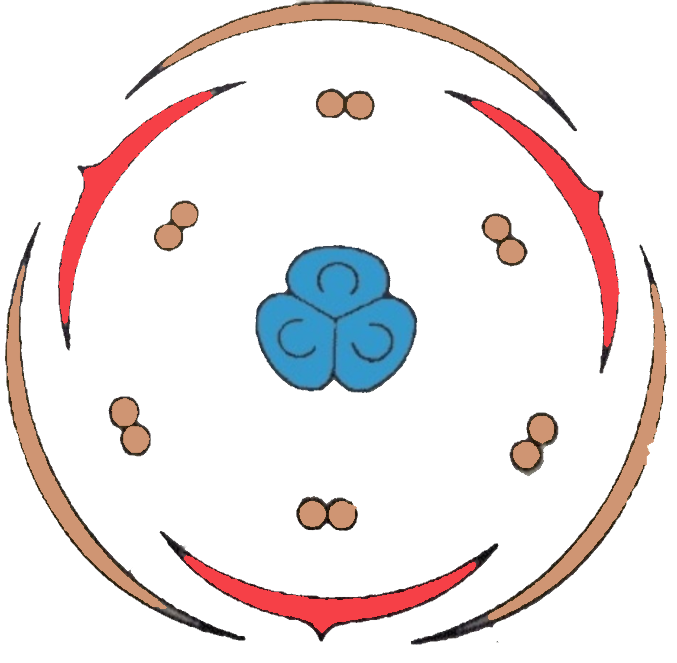
Which of the following has trimerous symmetric flowers?
a. Cactus
b. Lily
c. Fern
d. Cycas
Answer
494.1k+ views
Hint: A flower is symmetrical when each whorl consists of an equal number of parts or when the parts of anyone whorl are multiples of that preceding it. In trimerous symmetry, there is an arrangement in flower parts such as petals, sepals, and stamens, in sets of three.
Complete answer:
- Floral symmetry describes if and how a flower, in particular its perianth, can be divided into two or more identical or mirror-image parts.
- Monocotyledon plants are said to have trimerous symmetry.
- Lily belongs to the family Liliaceae. Lily is considered as an actinomorphic flower.
- Lily has a trimerous flower which means that it has six petals, six stamens, and six carpels.
- All lily flowers are symmetrical but the petals come in different shapes, and also differ in the hybrid division. Some lilies have reflexed petals, each petal curves backward.

In the diagram showing above we can see that the flower is having three similar segments or parts. The set of petals, sepals, and stamens are three.
Hence, The correct answer is option (B).
Additional information:
Flowers can be zygomorphic or actinomorphic based on their symmetry. Zygomorphic flowers are those which are divided into two equal planes whereas, in Actinomorphic flowers, flowers are dissected into two mirror images, even dissected from any plane.
Lily is a trimerous, actinomorphic, polyandrous, superior ovary, and axile placentation.
A cacti plant does not have trimerous symmetry. Plants of fern and cycad do not bear flowers, hence no trimerous symmetry.
Note: Trimerous symmetry is found in Monocots. Lily is a monocotyledonous plant characterized by parallel leaf venation, leaves are linear in shape, single or arranged in a rosette. Flowers can be distinguished based on other types of symmetry, namely radial symmetry, bilateral symmetry, and asymmetrical.
Complete answer:
- Floral symmetry describes if and how a flower, in particular its perianth, can be divided into two or more identical or mirror-image parts.
- Monocotyledon plants are said to have trimerous symmetry.
- Lily belongs to the family Liliaceae. Lily is considered as an actinomorphic flower.
- Lily has a trimerous flower which means that it has six petals, six stamens, and six carpels.
- All lily flowers are symmetrical but the petals come in different shapes, and also differ in the hybrid division. Some lilies have reflexed petals, each petal curves backward.

In the diagram showing above we can see that the flower is having three similar segments or parts. The set of petals, sepals, and stamens are three.
Hence, The correct answer is option (B).
Additional information:
Flowers can be zygomorphic or actinomorphic based on their symmetry. Zygomorphic flowers are those which are divided into two equal planes whereas, in Actinomorphic flowers, flowers are dissected into two mirror images, even dissected from any plane.
Lily is a trimerous, actinomorphic, polyandrous, superior ovary, and axile placentation.
A cacti plant does not have trimerous symmetry. Plants of fern and cycad do not bear flowers, hence no trimerous symmetry.
Note: Trimerous symmetry is found in Monocots. Lily is a monocotyledonous plant characterized by parallel leaf venation, leaves are linear in shape, single or arranged in a rosette. Flowers can be distinguished based on other types of symmetry, namely radial symmetry, bilateral symmetry, and asymmetrical.
Recently Updated Pages
The correct geometry and hybridization for XeF4 are class 11 chemistry CBSE

Water softening by Clarks process uses ACalcium bicarbonate class 11 chemistry CBSE

With reference to graphite and diamond which of the class 11 chemistry CBSE

A certain household has consumed 250 units of energy class 11 physics CBSE

The lightest metal known is A beryllium B lithium C class 11 chemistry CBSE

What is the formula mass of the iodine molecule class 11 chemistry CBSE

Trending doubts
State the laws of reflection of light

One Metric ton is equal to kg A 10000 B 1000 C 100 class 11 physics CBSE

Difference Between Prokaryotic Cells and Eukaryotic Cells

How do I convert ms to kmh Give an example class 11 physics CBSE

Give an example of a solid solution in which the solute class 11 chemistry CBSE

Describe the effects of the Second World War class 11 social science CBSE




